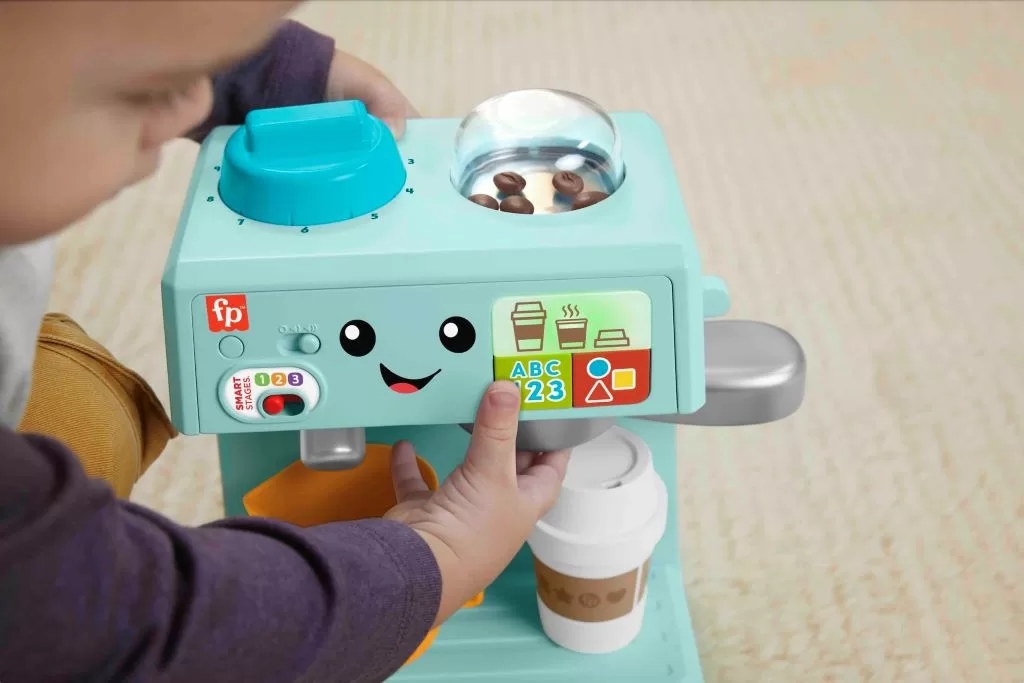The Importance of Pretend Play: Tips From A Childhood Development Expert

As your little one grows, their imagination is where they start to make sense of the world, how it all works, and the different roles grownups can play. From babbling on a toy phone, to “making” coffee with their Laugh n Learn Barista Set, pretend play helps your toddler learn how the real world works and how they might fit into it.
Manager of Early Childhood Development Research at the Fisher-Price Play Lab, and mom of 2, Dr. Lisa Lohiser (Ed.D.), has got a ton of frequent flyer miles to the land of make-believe. But in case it’s been a little while since you’ve visited, here is what you can expect as your little one grows, as well as some tips to help spark their imagination.
Why is pretend play important?
Pretend play lets toddlers explore the world around them in the comfort and wonder of their imagination. They can pretend to be a farmer harvesting crops, a veterinarian caring for their stuffed animal, or a barista who puts a smile on customers faces. The possibilities are endless!
As they describe what’s happening in their pretend scenario, your toddler is developing valuable language skills that help them speak, understand, and use words meaningfully.
Pretend play also encourages self-regulation and important emotions. Kids who have pretend wrestling matches or play similar games are learning impulse control and how to set and respect boundaries. Most importantly, your little one finds meaning and purpose through pretend play, which helps build their confidence and self-esteem.
Here are some tips and tricks to help your toddler get the hang of pretending:
· Expose your child to new places and experiences to add new tools to their pretend play toolbox. A trip to the coffee shop or camping in the outdoors can spark whole new play themes and possibilities!
· Use toy figures to “practice” a big or new event that is happening for your toddler, like going on a trip or starting a new school. Playing and practicing will help them become familiar so that new events won’t be so intimidating.
· Offer story starters to spark their imagination, such as “Is your stuffed bear thirsty? Do they like coffee too?” or put on a performance and let your little star run the show.
· Set them up for success! Toddlers can jump right into pretending when the toys they are using invite this type of play, particularly toy versions of grownup stuff.
· Play with them: Expand your tot’s pretend play skill set by introducing new, more complex stories rich with emotions, language, and fun props. For example, you can “go camping” indoors by working together to build a tent, then “roasting” marshmallows around the cozy fake fire.
How Pretend Play Develops
You’ll probably notice your toddler’s imitation play first (9-12 months), which centers on a simple action like tapping their tiny hands on a toy laptop or cradling a baby doll.
Typically, toddlers shift into pretend play around 2 years old. This is when you’ll see them act out familiar scenes and roles they see people perform in real life, like a parent caring for a baby or a doctor doing a checkup on a patient.
Here is a playtime favourites to spark your toddler’s imagination and encourage pretend play. The Fisher-Price Laugh & Learn, Learn & Serve Coffee Café Toddler Electronic Toy. Recommended for toddlers 18 months+, who can brew up endless cups of fresh pretend play. Styled like a real espresso machine, this interactive barista station comes with 10 role-play accessories and features 100+ songs, sounds and phrases that introduce the alphabet, colours, shapes and more. Kids can “grind” beans in the hopper, “steam” milk with the frother, and “brew” up drinks to serve their customers. And with Smart Stages® technology, the learning fun grows along with your child with 3 levels of play!





























